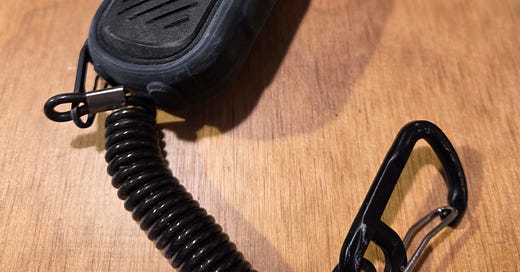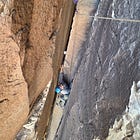I'm a Rock Climbing Secret Agent Now
Coming to terms with how technology can improve my guiding
I climbed for ten years before incorporating a communication device like walkie talkie into my climbing practice. Instead, I communicated the old-fashioned way– yelling at the top of my lungs in the general direction of my partner.
Or, on a gusty day, I shouted upwind to communicate louder. Sometimes, in a tight valley, I would yell overhead and in the direction of the opposing valley wall so the sound could echo back more clearly to my partner below. This was especially helpful when separated by large, looming roofs.
One time, I even remember getting a phone call while I was building a belay to bring up my partner. It was my partner below me, confirming that they were on belay and if they could start climbing.
When we couldn’t communicate due to weather or obstructing rock features, we relied on our instincts. Unspoken nuances of strong partnership did the communicating for us. Like the speed at which the rope was moving (or not moving), the length of the pitch compared to the duration of the lead, and rope tugs with pre-determined definitions.
When things were really unclear, extra precautions were always included in our plan to mitigate any catastrophic events from happening. For example, staying on belay until the bitter end of the rope while lead belaying. Or staying clipped to the anchor and climbing a few moves to see if the slack gets taken up before committing to the pitch.
The bottom line was (and is) that my partners and I always found a way.
Now, that “way” includes walkie talkies. Specifically– the Rocky Talkie Mountain Radio.
Adding Rocky Talkies to my kit
Rocky Talkies were always a piece of kit that someone else had. Therefore, I never needed a pair myself because I could always borrow them. When I did borrow Rocky Talkies, I mostly found them useful but never essential. I mostly ended up using them as a compromise with my climbing partner for the day.
However, I finally picked a pair for my trip to Red Rock National Conservation Area outside Las Vegas, Nevada.
The reasoning was that I knew I would be taking on bigger, longer routes, where reliable communication would inevitably be compromised. I wanted to see how the Rocky Talkies performed and if they could be “value added” to my guide kit when I’m out working.
My two cents about the Rocky Talkie, thus far
Rocky Talkies are rugged and reliable radios. The battery life is impressive, and they do a fine job facilitating communication while on a climbing route.
The radios themselves are easy to use. However, the carabiner they come with for clipping onto your harness feels somewhat clunky, and the orientation of the mounted radio on the gear loop is awkward. It’ll take some getting used to. (And I think I’ll switch out the carabiner for something smaller.)
While in Red Rock, I didn’t use the radio to communicate every single time. However, overall, the radios proved to be very handy.
For example, when I was climbing Group Therapy (5.7) with Drake, I linked some pitches together. This meant by the time I was done climbing and ready to belay Drake, I was well over 150 feet away, rendering verbal communication difficult. However, with a click of a button on the radio, I was able to communicate clearly.
Or, on top of Epinephrine (5.9) with Joe, when we were dealing with wind from being roughly 1,000 feet off the deck, we used the radios to bridge the communication void. Otherwise, our unreliable shouting would have been carried off into the wind, and the messages would not have been delivered correctly.
Communication as client care
Rocky climbing can be uncomfortable. You’re out in the elements, wearing weird shoes, shredding your fingertips, dealing with exposure, sitting on rocks, hiking steep trails, and getting a little scared.
Ironically, the uncomfortable components of rock climbing are what make the experience so fruitful.
However, there is such a thing as too much discomfort. Therefore, a lot of what I do as a climbing guide is to maximize my client’s physical comfort. For example, on a blistering hot day, I’m going to build my belays in the shade. For new climbers being introduced to multi-pitching, I will select routes with comfortable ledges and avoid exposing them to a hanging or semi-hanging belay.
I’m also paying attention to soothing my client’s emotional discomfort.
I mostly accomplish this with lots of communication. For example, if someone feels scared, I can gently coach them to remain calm, focus on breathing, and enjoy the awesome view. If anything about our climbing system is unclear, I can answer questions to alleviate anxiety and foster a rational understanding of how things work.
The crux of communication is that it’s best from a short distance. In other words, I can deliver higher-quality communication when I am physically closer to my client.
However, I can’t always be physically close. Sometimes, depending on the characteristics of the route, I’m inevitably further away. This can negatively impact the quality of our communication. When that happens, some folks can begin to question.
“Was that Teddy yelling off belay?”
“Was he talking to me?”
“I forget, when do I clean the anchor?”
“This gear is stuck, how do I get it out?”
Feeling uncertain about something, like when to take the leader off belay or start climbing, can exacerbate nervousness and anxiety. This worsens when I cannot quickly and reliably communicate to quell uncertainty.
However, with radios, I can mitigate a lot of the guessing game and the questioning, regardless of the distance between me and my partner. Moving forward, I am looking forward to being “in the ear” of my clients, especially if it means they feel more at ease.
Revamping my communication strategy with Rocky Talkies
As I mentioned above, my communication strategy over ten years of climbing involved a lot of yelling. It’s simple, technology-free, and, for the most part, reliable enough to get the job done.
I’ll continue communicating this way the majority of the time. It’s just the way climbing works.
Over the years, I was skeptical of radios. They seemed like an extra faff. And I always saw (or overheard) climbers using them to chat about what was happening instead of delivering critical messaging.
However, the more I use radios while climbing, the more I appreciate them.
I’m excited to deploy Rocky Talkies as a tool to deal with communication breakdowns, especially when I am guiding longer routes. The potential to improve how my clients feel by being able to communicate more readily in exchange for adding extra equipment to my kit seems well worth the investment.
Plus, let’s be honest– everyone loves feeling like a secret agent chatting with walkie-talkies.
This newsletter is entirely reader-supported. If you enjoy my writing, you can make a one-time donation at Buy Me a Coffee. Your support means a lot. Thank you!






I’m glad you’re on board with the rocky talkies!! I like em a lot. Plus u gotta be extra safe if you’re married to my Whitty
The secret agent vibe was fun high up on the wall with you, Teddy. It was also nice to quietly and confidently deliver or receive a message when people are on routes right next to us. Hopefully, they aren't too banged up from those spicy descents hanging on the harness. Probably wise to put them in the backpack at that point of the send.